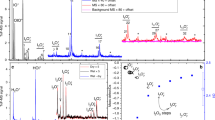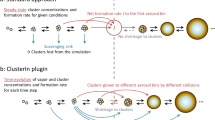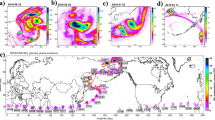Abstract
Measurements of CO2 in bubbles in polar ice have been used to establish a pre-industrial concentration1–4. Similar measurements have been made for other atmospheric constituents5,6. However, in order to use ice-core measurements to determine the increase in CO2 over the last 200 years, it is necessary to consider the time delay between the deposition of the original snow and the bubble trapping and also the distribution of trapping times over several decades7. The percolation model from lattice statistics describes the static geometrical aspects of trapping and reproduces various aspects of recent observations. The observations of large seasonal fluctuations in trapped bubble volume reflect the enhanced susceptibility to perturbations near the percolation transition. The critical exponent of the percolation probability largely determines the stability of the deconvolution of observed concentrations, indicating that the bubble deconvolution problem is less poorly posed than typical geochemical source deduction problems.
This is a preview of subscription content, access via your institution
Access options
Subscribe to this journal
Receive 51 print issues and online access
$199.00 per year
only $3.90 per issue
Buy this article
- Purchase on Springer Link
- Instant access to full article PDF
Prices may be subject to local taxes which are calculated during checkout
Similar content being viewed by others
References
Berner, W., Stauffer, B. & Oeschger, H. Nature 276, 53–55 (1978).
Delmas, R. J., Ascencio, J.-M. & Legrand, M. Nature 284, 155–157 (1980).
Neftel, A., Oeschger, H., Schwander, J., Stauffer, B. & Zumbrunn, R. Nature 295, 220–223 (1982).
Barnola, J. M., Raynaud, D., Neftel, A. & Oeschger, H. Nature 303, 410–412 (1983).
Berner, W., Oeschger, H. & Stauffer, B. Radiocarbon 22, 227–235 (1980).
Craig, H. & Chou, C. C. Geophys. Res. Lett. 9, 1221–1224 (1982).
Schwander, J. & Stauffer, B. Nature 311, 45–47 (1984).
Shante, V. K. S. & Kirkpatrick, S. Adv. Phys. 20, 325–327 (1971).
Essam, J. W. Phase Transitions and Critical Phenomena Vol. 2 (ed. Domb, C. & Green, M. S.) Ch. 2 (Academic, New York, 1974).
Deutscher, G., Zallen, R. & Adler, J. (eds) Percolation Structures and Processes (Ann. Israel Phys. Soc. Vol. 5) (Hilger, Bristol, 1983).
Kasteleyn, P. W. & Fortuin, C. M. J. phys. Soc. Japan 26 (Suppl.), 11 (1969).
Wu, F. Y. Rev. mod. Phys. 54, 235–268 (1982).
Wilson, K. G. Rev. mod. Phys. 55, 583–600 (1983).
Domb, C. in Phase Transitions and Critical Phenomena (eds Domb, C. & Green, M. S.) 464 (Academic, New York, 1974).
Nienhuis, B., Reidel, E. K. & Schick, M. J. Phys. A13, L189 (1980).
Pearson, R. B. Phys. Rev. B22, 2579 (1980).
Gaunt, D. S. & Sykes, M. F. J. Phys. A16, 783–800 (1983).
Loosi, H. H. Earth planet. Sci. Lett. 63, 51–62 (1983).
Ross, B. Lect. Not. Math. 457, 1–36 (1974).
Anderssen, R. S. & de Hoog, F. R. Math. Scient. 8, 115–141 (1983).
Author information
Authors and Affiliations
Rights and permissions
About this article
Cite this article
Enting, I. A lattice statistics model for the age distribution of air bubbles in polar ice. Nature 315, 654–655 (1985). https://doi.org/10.1038/315654a0
Received:
Accepted:
Issue Date:
DOI: https://doi.org/10.1038/315654a0
This article is cited by
-
The effective age of bubbles in polar ice
Pure and Applied Geophysics PAGEOPH (1985)
Comments
By submitting a comment you agree to abide by our Terms and Community Guidelines. If you find something abusive or that does not comply with our terms or guidelines please flag it as inappropriate.



